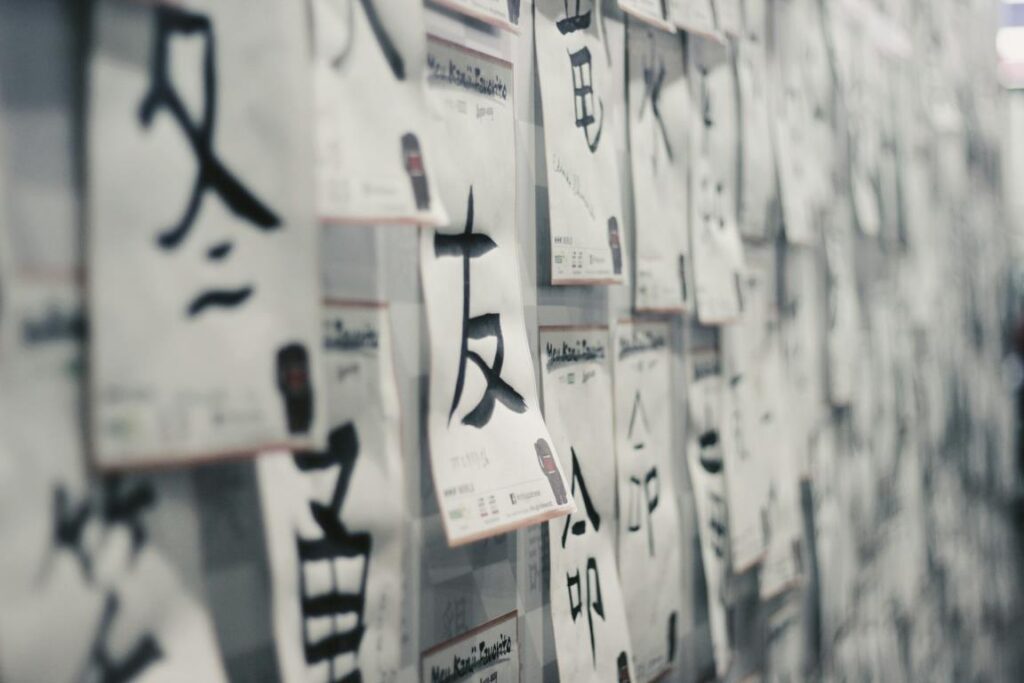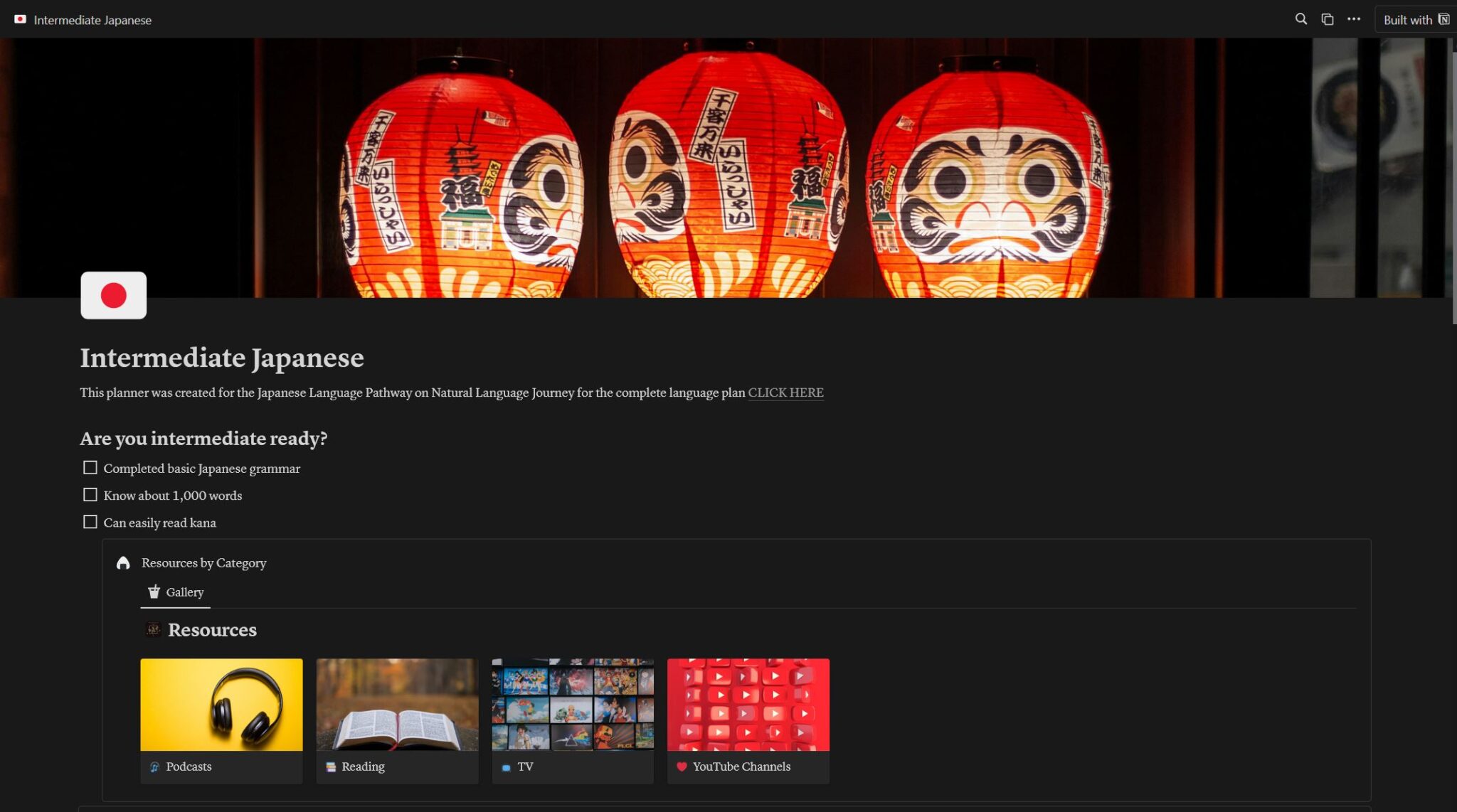Writing is a great way to practice using the Japanese you’ve learned without the time pressure of speaking. If you feel comfortable reading Japanese at an intermediate level or above, you are ready to start writing! While the best feedback generally comes from native speakers, ChatGPT is a great way to practice and get feedback on your writing for free! ChatGPT can provide you with prompts and examples, correct your mistakes, and offer targeted feedback and practice.
To get started, create a new chat and ask ChatGPT to give you a topic for your Japanese level. In the image below, I asked for an N3 essay topic. Additionally, I prefer to ask questions in my target language, so I get as much immersion as possible, but you can ask for ideas or feedback in any language!
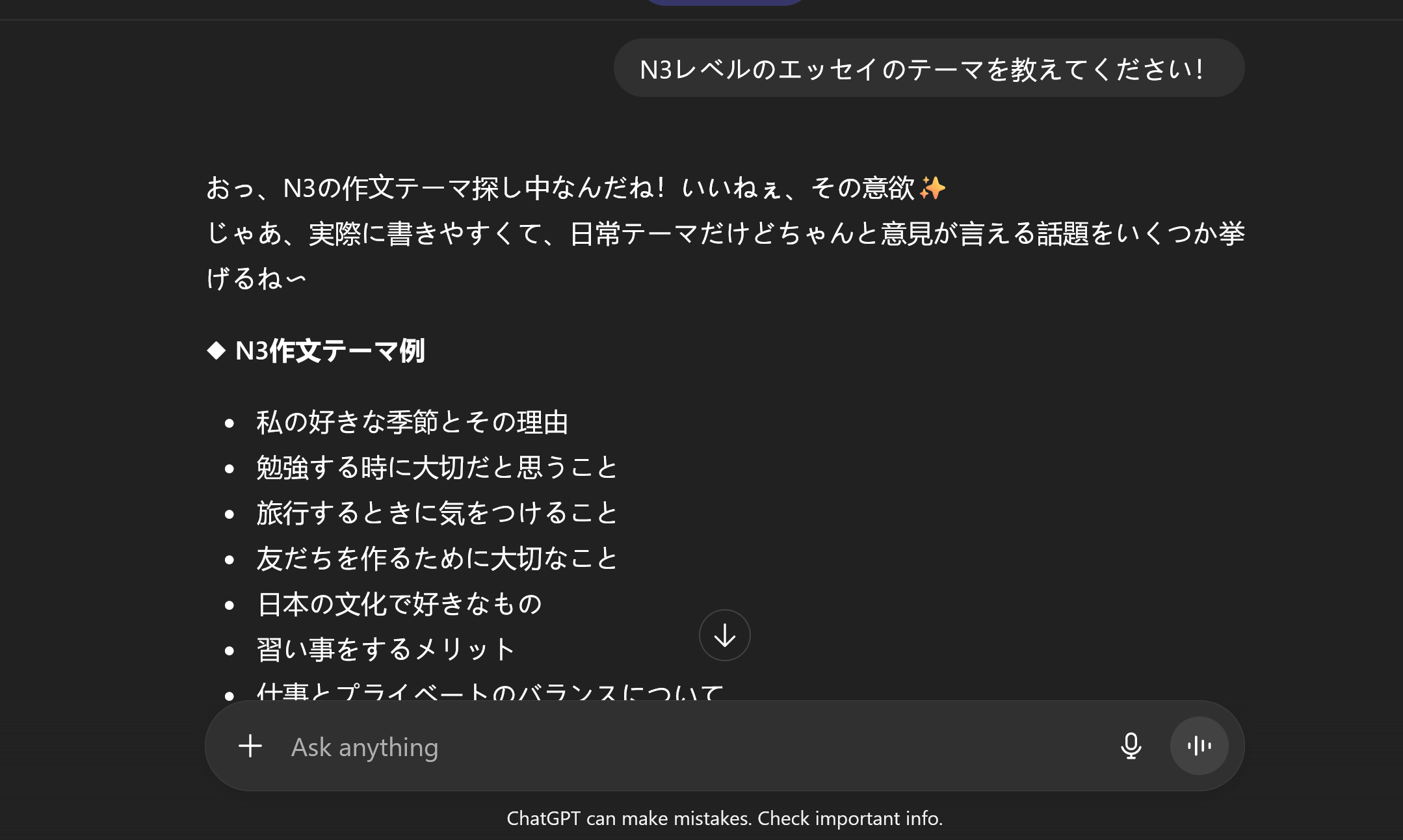
Next, copy the prompt and paste it into a word processor like Google Docs or Word, and write a short essay following the prompt.
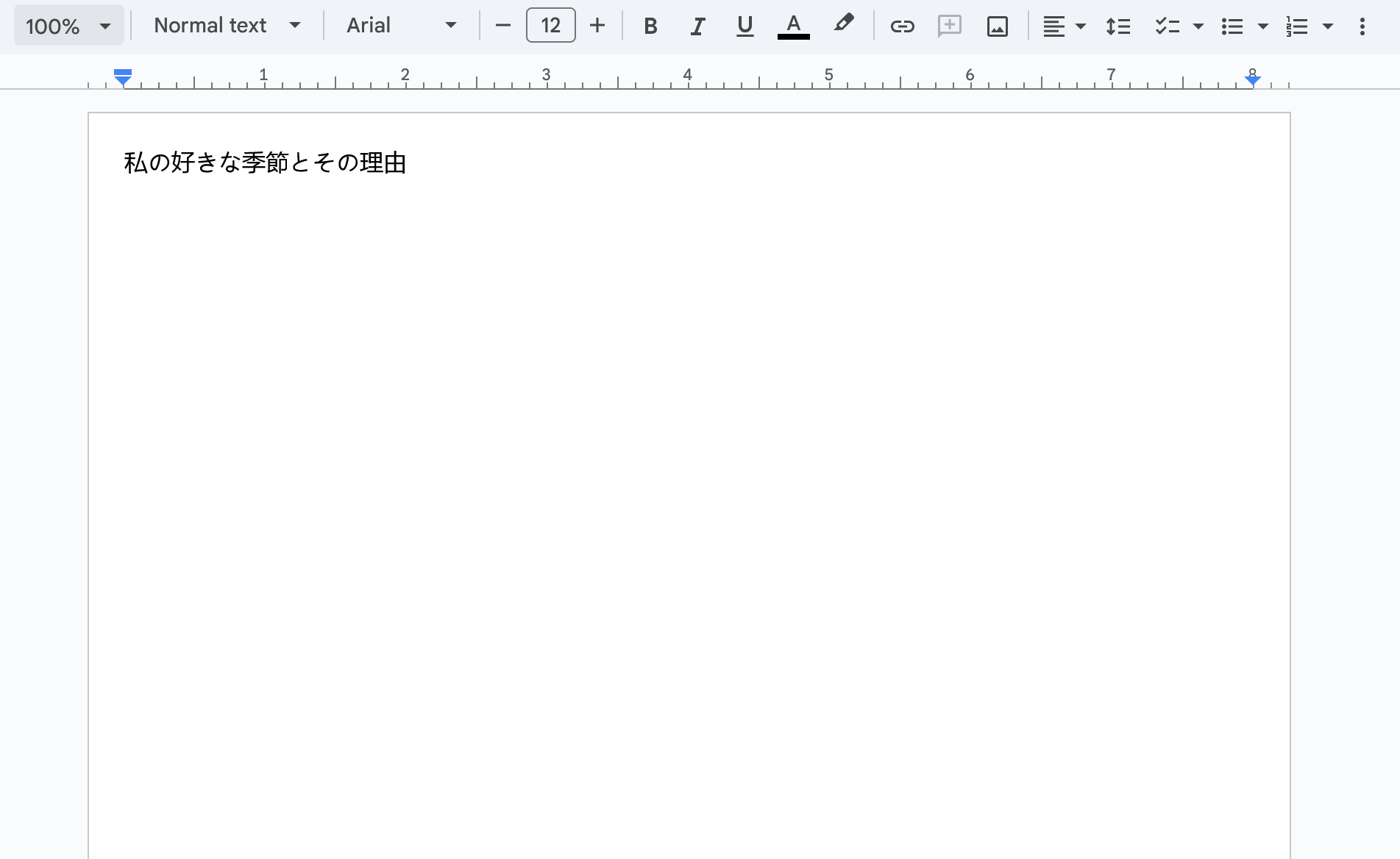
When you write, only look up single vocabulary, set phrases, or grammar patterns! DO NOT use a translator to translate full sentences; just do your best to write using your current knowledge! It’s ok if you make mistakes, that’s how you learn, and you will receive corrections and feedback later!
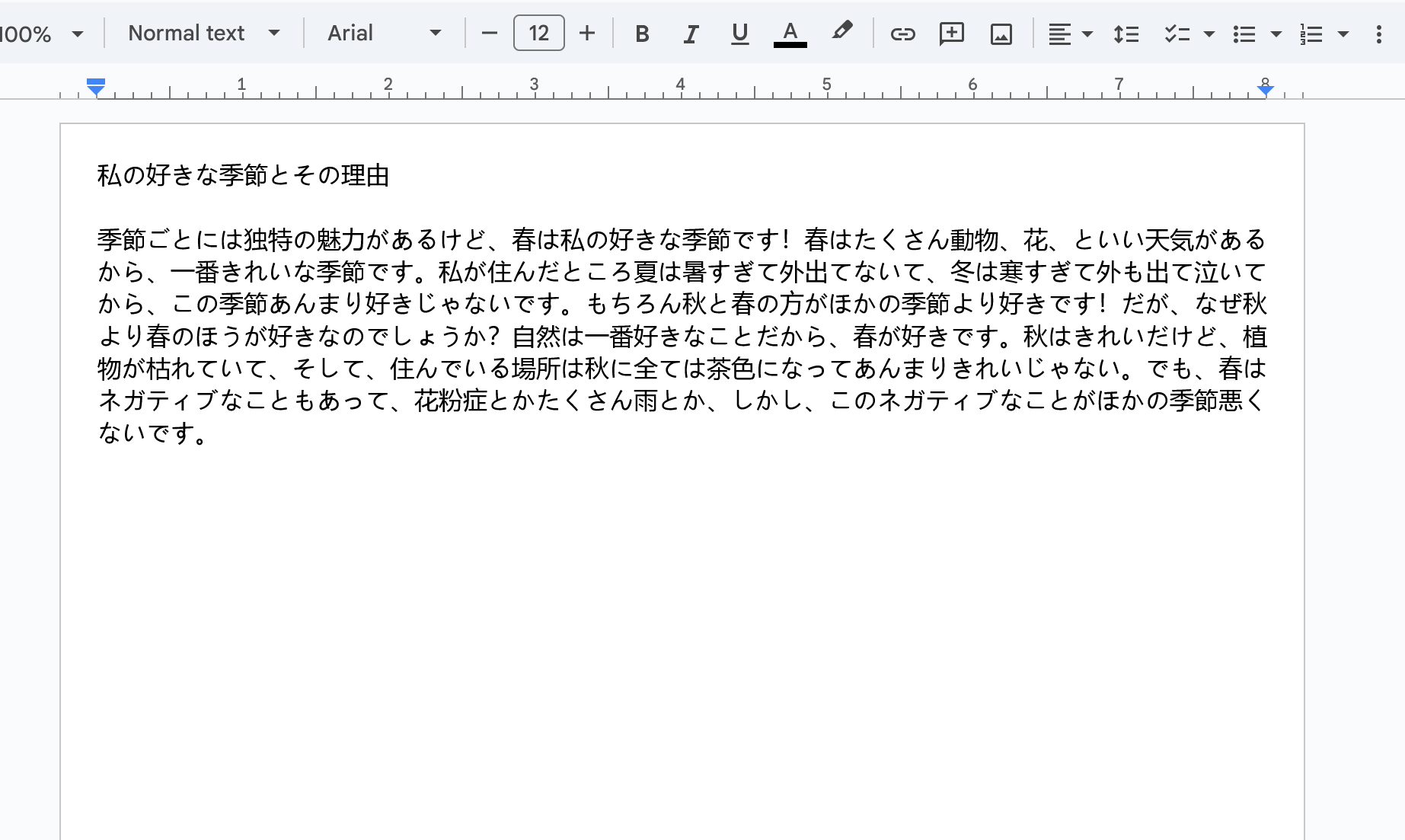
When you are done writing, paste your short essay into ChatGPT for evaluation. ChatGPT will give you a corrected version as well as feedback on your weakest areas!

Back in your Word document, type out the corrected version of your essay and take note of any differences from your original writing. DO NOT copy and paste the corrected version! Typing it out will help you remember the corrections better!

After you’ve looked through the corrected version, you can ask ChatGPT to explain the changes it made and why.
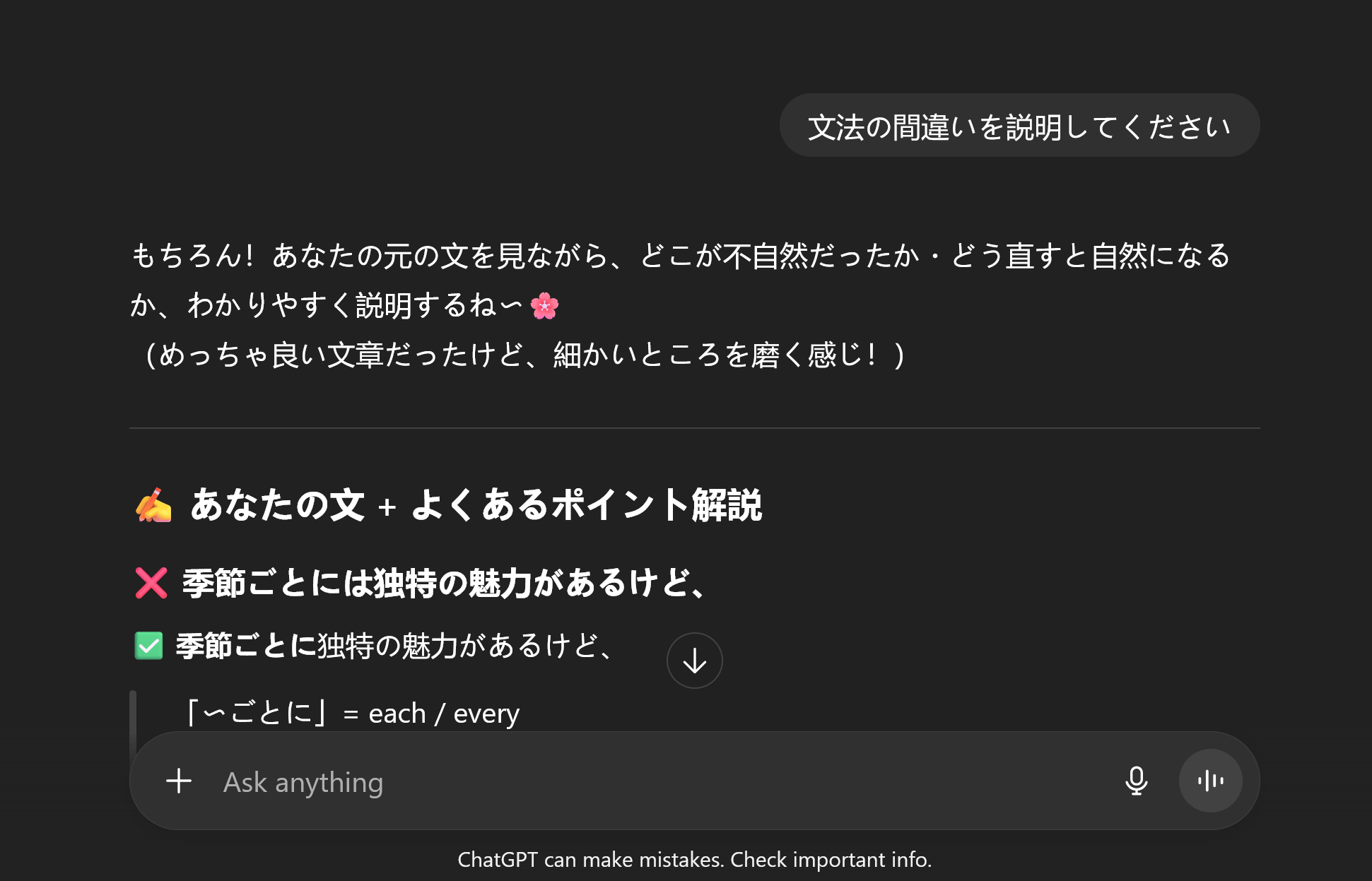
You can also ask ChatGPT to make you targeted practice for your weakest areas in the form of quizzes or prompts!

After you have worked your way through a prompt, ChatGPT will generally give you new ones to choose from. You can then choose from one of its suggestions or ask for a different prompt! Continue practicing a few times a week, and you will see your writing ability improve dramatically!
How to Write About New Topics
Whether you want to write a letter, a blog post, an essay, or a book, you need input from the same type of material to know what to do. You can’t write a book without reading one first. The idea behind this method is to get input from sources that discuss the same material you want to write about, then rewrite the topic in your own words. When you start, you may use this method to write a simple message or a letter, but as you advance, you can use it to write more advanced pieces like a short story or an essay. In this example, I am going to write a thank-you letter, which I would consider to be of moderate difficulty, but this is the same technique I use for writing my much more complex blog posts. When you first start writing, you should start with something simple and work your way up. If you choose a topic that is too difficult or try to write in the same way you write in your native language, you will be frustrated by how much time it takes. Don’t compare your writing in Japanese to your writing in your native language. You’ve had a lot more time to practice your native language, so it’s not comparable. You should start with topics that you are familiar with in your native language and that will be relevant to you. Fluency comes in pockets, so you want to practice the stuff you need the most first. This is a great way of learning new words and phrases relevant to your interests. If you find this technique is too difficult for you, practice reading some more and come back to it later.
Not sure what to write about, and looking for a prompt to use this technique with? Below you will find lots of different prompts to practice your writing. Choose a prompt about a topic you are familiar with. How much you write will depend on your Japanese level. It’s ok if you can only write a paragraph or two; that’s still infinitely more than nothing at all.
What You Will Need
Besides a word processor such as Microsoft Word or Google Docs, you will use Reverso Context, a Japanese-English dictionary, and ChatGPT for this method. Have these websites open in separate tabs as you write so you can reference them at any time.
You will probably also want to use some of the reading assistance tools talked about in the article below if you don’t use them regularly already. This will make understanding what you are researching much easier.
Letter Example
First, you need to choose the topic you want to write about and Google it. If you don’t know how to phrase the topic you are looking for, use Reverso Context or ChatGPT to help you. In this case, I want to write a thank-you letter for a bag my friend gave me as a present, so I want to see examples of other thank-you letters in Japanese. I’ll start by googling “thank-you letter” and opening a few sites to see if they have what I’m looking for. Here, the first link isn’t useful because it’s an advertisement for the thank-you letters Family Mart sells. The second link is an article about how to thank someone and different phrases for saying thanks. That could be useful. I’ll keep that tab open.

If you find that most of the pages recommended to you are in Chinese or English, even though you’re searching in Japanese, you’ll need to change Google’s search language. To do this, go to your profile in the top right corner and select “Language.”

In “language and region,” change the “results language filter” to search for posts in both Japanese and English. You may also change your “results region” to Japan so that Google gives you more Japanese websites.

Back on the search results, a little farther down, there’s a news site with several thank-you letter articles. These articles are mostly thank-you letters to parents, but they may still have some useful information, so I’ll read through a few of them. The first one I read through was a letter of thanks from a woman in her 50s to her father who had passed. While an interesting and touching read, it is written in heavy Kanzai dialect, which I don’t want as a reference since I want to write in standard Japanese, and it also isn’t very relevant to what I want to say thank you for, so I closed it. The second article I read was from an older woman to Tan, a Vietnamese boy she went to school with in 1967, and what she would say to him if she could see him again. She would thank him for his open nature and desire for peace. While this article was again not really what I was looking for, it was an interesting read and might have some useful phrases, so I’ll keep it open for now.

Since I’m not finding what I’m looking for, I’m going to go back to Google and change my keywords. This time, I’m going to search “thank-you letter present” and see if that turns up any different results. You may also see if Google has any related search suggestions for you as well. Already my results look like they fit my topic much better. The first result is about how to write a thank-you message when someone gives you a souvenir as a gift. Several of the following websites also have generic thank-you letter templates. After reading through the websites though, I found that all but one used very formal keigo and were more geared toward saying thank-you to your boss or co-worker.

After going back to Google one more time and changing my search query to “present thank-you letter friend,” I finally found several different examples that I liked. However, all that previous reading was not in vain. I learned a lot about Japanese thank-you letters by reading through so many different ones. A lot of sites also talked about the cultural etiquette surrounding thank-you letters as well, since the language for giving thanks in Japanese is extremely varied depending on who you are talking to. By researching this topic, I read several articles I would have never been exposed to otherwise, which is great for expanding my Japanese.

If you are struggling to find relevant examples, you can always ask ChatGPT for a more specific example. Here I asked ChatGPT to provide me with an example of a thank-you letter for a present from a close friend. I won’t copy this exactly, but I can use it to get ideas and help with my outline.

Now, it’s time to start writing my letter. On one half of my screen, I have my Word document, while on the other half, I have my example text. This is easiest on a desktop, but you can do this on a phone as well. I recommend choosing one reference to use as your outline, while the other references will serve as sentence reservoirs. The first sentence in this letter is based on the first sentence from the text above, while the last sentence is copied directly from the text below because it is a set phrase. You should use the sentences in the example as outlines that you can put your own information into. In this letter, I decided to thank my friend 奈美 (Nami) for giving me a new bag as a present. If you read through the example letters and then read through my letter, you should see where I pulled sentences from and where I changed things. I try to keep direct copying to a minimum unless it’s a common phrase. This will make my writing sound more unique and help me build stronger writing skills.

If you need to look up a phrase or word to use in your sentence, both Reverso Context and Weiblo will give you a bunch of example sentences to help you find what you are looking for. In this case, I wanted to say that the bag my friend got me is stylish and useful. After scrolling through some example sentences, I decided that the best way to say this would be 便利でおしゃれ. There may be many different ways to phrase what you want to say, so just go with the one you think is best. You’ll see how to correct your writing later.

If you really aren’t sure how to phrase something, and Reverso and Weiblo aren’t helping, you can go to ChatGPT and ask it how to say what you’re looking for. ChatGPT is extremely useful, but it needs to be used as a tool, not as a translator. If you rely on it too much to translate everything for you, your Japanese will not improve. You should only use ChatGPT for support, don’t copy anything directly.

Once you’re done writing your letter, you’re going to put it into ChatGPT and ask it to correct what you wrote so it sounds natural. It’s important to ask ChatGPT to make it sound natural because it tends to make your writing sound stiff and formal if you don’t. To ask ChatGPT to correct your writing in Japanese, you will write, “これを自然な感じに修正してください.” If you want it to be corrected in casual Japanese, then tell it “カジュアルな日本語で書いてください.” Then copy the text you’ve written into the chat box and press send. It will immediately send you the corrected version of your writing. If you would like it to explain the changes it made, you can write “文法を説明してください.” If the Japanese explanation is too difficult, you can also ask it to explain the grammar in English.

Next, we’re going to compare the corrected version of the letter to our own. Don’t just copy what ChatGPT spits out and make that your letter, instead go over it one sentence at a time to see what it changed. In my case, most of the changes it made were minor. It changed かばん to バッグ since that fits better with the context of this letter, and it changed some of the phrasing around like いつもありがとう to いてくれて本当にありがとう。

For the last step, you are going to type out the corrected version of the letter by hand. Typing it yourself will help you remember the corrections much better than just reading it. You may also write it out on paper by hand if you would like to do so, but it’s not necessary. Once you’ve written out your final letter, that’s it. Congratulations! Now all you need to do is keep practicing, and you’re well on your way to writing in complex, natural-sounding Japanese. This will also help with your speaking and comprehension since you will pick up new words and phrases along the way. You can use this technique to write anything you want: dialogues, stories, articles. All of these are great for practicing your Japanese! I recommend starting a blog, journal, or social media page in Japanese where you can track your progress and store your writing. You’ll be amazed at how quickly your writing ability improves!


